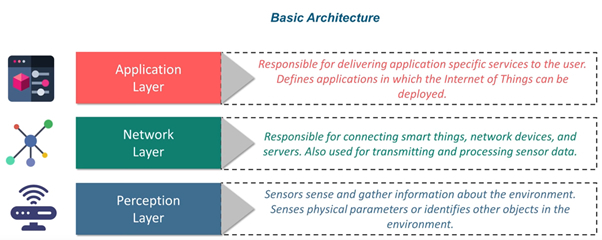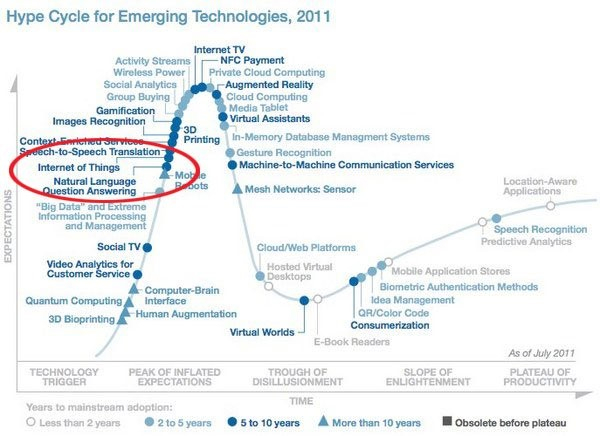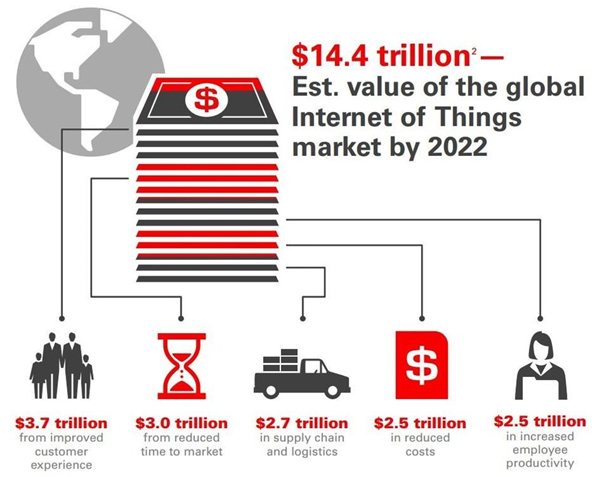Have you ever imagined what will happen if the electronic devices and gadgets you have at home will be able to communicate with each other and with you as well? When your morning clock is connected to the toaster, coffee machine, and music system, and also connected to the Internet, they can work in coordination with each other for your comfort. This way, you will have a hot meal prepared for you while you were getting dressed and listening to your favorite music. This is just a simple example of the Internet of Things.
Today, in the era of technological advancement, IoT is a wonderful tool that can combine and coordinate a lot of other things that make your life better. IoT has certainly been moving full speed ahead the last few years, so today many companies already offer IoT platforms as a service. Amazon, Google, and Microsoft have their own IoT services, but there are many other solutions on the market as well. These platforms allow developers to build smart IoT solutions and turn the immense amounts of data into actual value with minimum disruption in the existing development process. Join us today to discover the facts of the Internet of Things you probably didn’t know, learn about top IoT platforms, and more!
The Internet of Things Basics
There are many different explanations that define what the Internet of Things actually is. We will go with the simplest yet the most informative one. Internet of Things is an interaction between two worlds – physical and digital – made possible with sensors and actuators in order to solve tasks that usually require doing complex parallel actions. The main goal of IoT is to help everyone to ease up their tasks and daily routines with various devices that are united in one network and complement each other.
When it comes down to the architecture of IoT ecosystems, there is no single unified design used by everyone. However, we can still describe a basic architecture that consists of three layers, which are:
- Perception layer. Sensors pick up and gather information from the environment. On this level, the system analyzes the physical parameters of the objects found in the environment. Then they pass this information to the next layer.
- Network layer. It takes the responsibility of transferring the data acquired by the perception layer to the application layer. This layer connects all devices and servers into one network.
- Application layer. The main objective of this layer is to deliver the information to the end-user (or end platform). It also defines the applications that can be used for the IoT deployment.

Let’s take automation of a simple process as an example: open the garage door when a car approaches. In order to automate this with IoT, you need two sensors – one on the garage and one in the car. When the car sensor is able to reach the stationary one in your garage, the system will automatically know that you are near, and it will open the gate for you.
It turns out that many people nowadays don’t distinguish IoT and AI. So we feel like a short explanation is required here. In AI-integrated systems, machines make decisions based on their past experiences. They continuously try to improve their performance by learning from their past actions to be able to reach the goal in a more efficient way. Here machines and devices are not coded with what to do/not to do. Instead, they are coded with the ability to learn and understand their roles. For a more in-depth explanation on this topic, we recommend you to check other articles about machine learning in our blog.
How It All Started?
The term “Internet of Things” was invented by Kevin Ashton in the mid-nineties. He noticed that the production optimization depends on two factors – the speed of data transferring and data processing. When managers are retrieving information from all available sources manually, it may take days to finish simple tasks. But with radio frequency identification (RFID), it is possible to speed up the process of transferring data between devices. So the most logical way to do the job efficiently, in this case, would be to take humans out of the equation and let machines send and process data themselves. This idea needed a name, and Ashton decided to call it the “Internet of Things.”
It took almost a decade for this term to get into action. Along with artificial intelligence, IoT has become the forefront in the development of information technology. In 2008, IPSO Alliance started promoting the Internet of Things and united its efforts with other companies looking forward to this technology.
In the summer of 2010, the world found out that Google StreetView is not only doing panoramic photos but can also collect data from the Wi-Fi networks. IT experts immediately started speculating about a new data transfer protocol that will allow devices to share data. In the same year, the government of China announced that they have plans to make IoT one of the top priorities in the nearest future. And in 2011, Gartner has added the Internet of Things to their “Hype Cycle,” which is basically a list of the most promising technologies that are currently developing.

The IoT concept was taking over the world. The LeWeb 2012 conference was dedicated to this topic, and mass media started actively pushing the term “Internet of Things” into their articles. IoT has suddenly become a trend, and companies started exploring the newly formed market. In 2014, Cisco has predicted that in 2022, the IoT market will be estimated at $14.4 trillion.

How to Choose an IoT Platform for Your Business?
The IoT market has no shortage of various solutions for small and medium businesses as well as gigantic corporations. The number of IoT platforms has already exceeded 300 and continues to grow. It can be really hard to choose an optimal platform for your business because different companies use different approaches to this technology.
In our experience, there are five main requirements you must consider before picking an IoT platform. Usually, service providers offer a variety of plans to choose from, so for this matter, we are not going to discuss cost-efficiency because it depends on your plans for the project. So, here are the questions you should ask your IoT company before buying their product.
- Is the platform secure? You must be sure that everything is protected not only on a technical level, but also that the service is operated by trustworthy people that understand the importance of following the security standards common for the industry. The more security features and advanced monitoring tools the platform can offer, the better.
- Is it reliable? Every system may fail due to unexpected errors, and when you’re dealing with the system of interconnected IoT devices, you must have a perfect connection. Or at least have additional measures to help you fix problems automatically. This automation feature is crucial because there will be no humans to reset or reconnect devices manually if something goes wrong.
- Does it have good scalability? You may never know if your product is going to be a big success or not. Anyway, you need to have the ability to scale as you go – it would be a major problem if you are limited in the number of devices that can be added to the system. Also, the connectivity layer on the chosen platform must be robust to handle interactions between numerous devices.
- Can it offer the flexibility I need? We often use various tools developed by third-party organizations to enhance products and provide a better user experience. Besides integrations, you may want to have some applications that gather data for analytics. Flexible IoT platforms allow you to have an almost endless number of integrations while also giving tools to manage them the way you see fit.
- Is it user-friendly? When it comes to user interfaces, there is one golden rule – the simpler, the better. The platform interface must be laconic and intuitive, so you won’t be wasting a lot of time learning how it works, how to change or apply new configuration settings, and so on. Also, it would be nice to have some automation features to perform scheduled tasks or react immediately to unexpected network issues.
Overview of The Main IoT Service Providers
IoT has evolved into a service that can be used by organizations on an industrial scale. Today you can see even mining companies (Rio Tinto, Australia) and power companies (Enel, Italy) using IoT solutions for the optimization of their activities. Needless to say that smaller projects like smart houses or self-driving cars are also in high demand.
The market of IoT solutions is vast, so it may be difficult to choose a service provider that will handle your specific tasks. If the budget is not a big concern for you, then we would recommend going to one of the top providers – Amazon, Microsoft, or Google. But even if you are not ready to spend your money on the full spectre of IoT services, you, at least, should know what lies in store. So here is our quick comparison of the main IoT tools and services you can buy today.
Amazon Web Services
No one can beat Amazon in terms of available IoT services at the moment. Alas, not everyone can also afford a full stack of their solutions because they are not cheap. AWS provides both Edge and Cloud services for IoT projects. The first category is for developers that need to build networks of devices, gather data, analyze and make decisions without an active Internet connection. It is the best option for remote complexes far from civilization. As for cloud services, they offer more flexibility allowing not only connect devices in one network and maintain their health but also detect anomaly actions and respond to them via IoT applications and sensors.
Edge solutions must be deployed close to the source of the data because you cannot just upload information to a cloud for processing. There are two tools in this category:
- AWS FreeRTOS: even the smallest edge devices that consume low amounts of power need an operating system to keep everything in check. This is what FreeRTOS does – it lets you deploy/connect/manage edge devices. Those can also be connected to other edge devices with Amazon IoT Greengrass.
- AWS IoT Greengrass: this software is designed for data caching, filtering, synchronization, and computing in a secure way. In other words, it helps local devices to process large volumes of generated data.
Amazon IoT cloud services are more diverse, so here is a table with the services and their brief descriptions:
- IoT Core. Managed cloud service. All connected devices can securely interact with the apps in the cloud and other devices. Supports thousands of devices and can process billions of messages that can be re-routed to AWS endpoints or other devices.
- IoT Device Management. The tool for organizing, monitoring, and managing IoT devices. Troubleshooting and health checking of connected devices included. Allows over-the-air firmware updates.
- IoT Device Defender. Provides security measures based on auditing IoT configurations. Assures that you are using the latest and most effective security practices.
- IoT Analytics. Processes the gathered data using complex algorithms and provides insights based on the analysis.
- IoT SiteWise. Managed niche service for retrieving/organizing information from industrial equipment.
- IoT Events. The tool that helps taking necessary actions to deal with events detected by sensors and IoT applications.
- IoT Things Graph. The service that visualizes the connection between connected devices and web services. Used for developing IoT applications.
Microsoft Azure
Billions of devices are already connected and managed by Azure Internet of Things that offers precise control over each asset, great monitoring tools, and stable connection. In comparison with Amazon or Google solutions in this niche, Microsoft is cheaper. Today Azure IoT is the second most popular choice on the market.

Microsoft markets its Internet of Things solutions using two models – Platform-as-a-Service and Software-as-a-Service – with the latter being much more diverse. The PaaS model includes Azure IoT solution accelerators and Azure Digital Twins products.
IoT solutions accelerators are essentially complete IoT solutions based on the most common uses of IoT technology (device simulation, remote monitoring, predictive maintenance, etc.). These accelerators can be deployed right away or customized according to your specific needs. The visualization requires JS coding, while back-end alteration needs mainly .NET skills.
Azure Digital Twins is the service for creating detailed models of the physical environment. After scanning, you receive a comprehensive digital model of the place that can be used to visualize current or planned relationships between people and devices. Often used for optimizing available space, energy requirements, and so on.
In terms of SaaS, this is what Microsoft Azure has to offer:
- Azure IoT Central. First service in the line to all necessary things from connecting to managing. Allows using templates for different types of devices to test how basic IoT Central applications will perform. Comes with tools for device monitoring but mostly straightforward ones.
- Azure IoT Cloud Services. Various services for standard IoT routines (connecting devices, analyzing data, etc.).
- IoT Hub. Allows connecting all your IoT-ready devices to one hub to simplify controlling procedures.
- IoT Edge. An addition to the IoT Hub for analyzing data on the devices themselves instead of the cloud. The most workload is shifted to the Edge, although messages are sent through the cloud.
- Azure Maps. Provides geodata for mobile/web apps.
- Time Series Insights. A service for storing, visualizing, and processing time-series data from IoT devices.
Google Cloud
Google is the world's third cloud services provider, so naturally, the company has also something to offer in terms of IoT. Their solutions might not be the cheapest and not the most diversified but Google certainly makes the developers’ life easier with its IoT products. The crown of their collection is certainly Cloud IoT Core.
Cloud IoT Core is a managed service that allows connecting numerous devices and then retrieve the data they collected. Everything you gather with it can be analyzed, processed, and even visualized in real-time for getting the most accurate results and ensuring the best efficiency. Cloud IoT Core uses the serverless infrastructure of Google, which means that it scales automatically upon changes are made.
The Core solution is also enhanced with Google Cloud data analytics that allows you to analyze the performance of the system in all the places that matter. In addition to advanced analytics, you can use the gathered information for machine learning, visualization, and so on. This way it becomes possible to detect weak spots in your system or create optimized models for any imaginable scenario.
Other notable IoT services by Google:
- Cloud Pub/Sub. Fully managed service that receives and delivers messages between independent apps in real-time. Supports device-to-cloud.
- Cloud IoT Edge. Extends GCP’s data processing and ML (machine learning) capabilities to various edge devices. Helps them with making decisions based on the information received from sensors. Can be run on Android as well as Linux.
Conclusion
Internet of Things has become a major trend for a reason, and today it promises a lot of efficient solutions for both daily and very specific industrial tasks. The variety of IoT platforms grows with each year making it harder to choose the best variant for your project. However, all major providers we reviewed in this article offer wide range options along with certain benefits. If you cannot decide which service to pick, the optimal course of action would be to opt for those that offer a free trial. This way you will be able to test your idea and launch the project on a minimal budget to see how it goes. AWS, for example, can offer basic IoT services for free but with certain limitations.
Obviously, each project is unique with its special requirements for security, scalability, and flexibility. To find an ideal environment for building an IoT system, we recommend consulting with professionals first. Contact us at SSA Group to discuss the details of your IoT project, and our specialists will find the best technological solution that will allow you to create any application according to your requirements.







